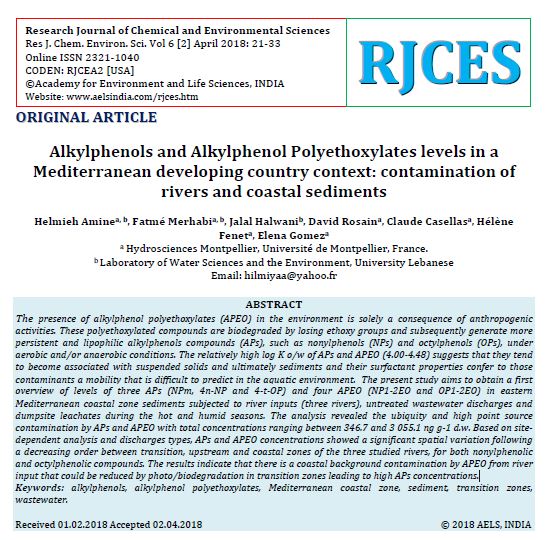Alkylphenols and Alkylphenol Polyethoxylates levels in a Mediterranean developing country context: contamination of rivers and coastal sediments
 |
thèse Apr 2018
Ed. LU - Beirut
Téléchargeable sous format: PdF
Abstract:
The presence of alkylphenol polyethoxylates (APEO) in the environment is solely a consequence of anthropogenic activities. These polyethoxylated compounds are biodegraded by losing ethoxy groups and subsequently generate more persistent and lipophilic alkylphenols compounds (APs), such as nonylphenols (NPs) and octylphenols (OPs), under
aerobic and/or anaerobic conditions. The relatively high log K o/w of APs and APEO (4.00-4.48) suggests that they tend to become associated with suspended solids and ultimately sediments and their surfactant properties confer to those contaminants a mobility that is difficult to predict in the aquatic environment. The present study aims to obtain a first overview of levels of three APs (NPm, 4n-NP and 4-t-OP) and four APEO (NP1-2EO and OP1-2EO) in eastern Mediterranean coastal zone sediments subjected to river inputs (three rivers), untreated wastewater discharges and dumpsite leachates during the hot and humid seasons. The analysis revealed the ubiquity and high point source contamination by APs and APEO with total concentrations ranging between 346.7 and 3 055.1 ng g-1 d.w. Based on sitedependent analysis and discharges types, APs and APEO concentrations showed a significant spatial variation following a decreasing order between transition, upstream and coastal zones of the three studied rivers, for both nonylphenolic and octylphenolic compounds. The results indicate that there is a coastal background contamination by APEO from river input that could be reduced by photo/biodegradation in transition zones leading to high APs concentrations.
Pays concerné: |
Editeur/Diffuseur: |
|
LU
-
Université Libanaise - Beirut - Liban |
En cas de lien brisé, nous le mentionner à communication@pseau.org